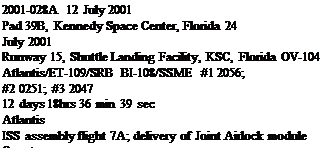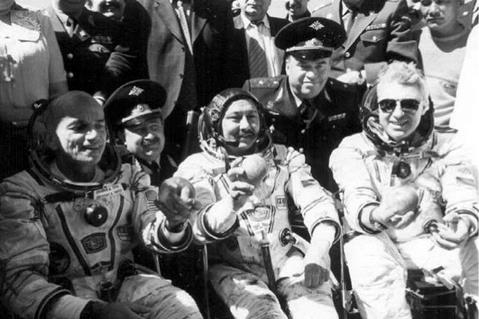. SOYUZ TM32
Flight Crew
MUSABAYEV, Talgat Amangeldyevich, 50, Russian Air Force, commander, 3rd mission
Previous missions: Soyuz TM19 (1994); Soyuz TM27 (1998)
BATURIN, Yuri Mikhailovich, 51, Russian political aide, flight engineer,
2nd mission
Previous mission: Soyuz TM28 (1998)
TITO, Dennis, 60, civilian, US space flight participant
Flight Log
Soyuz TM32 was scheduled to be the mission that exchanged the Soyuz (TM31) that had carried the first resident crew to the station six months before. The mission was also known as Taxi-1. However, just to confuse things, the Russians decided to rename these missions (and the Progress flights) by order of flight sequence to the new station. So Soyuz TM31 became Soyuz 1 (the original of which actually flew in 1967) and the first Progress (M1-3) became Progress 1 (which originally flew in 1978). Soyuz visiting missions had been conducted for some time with their own space stations, with Russian cosmonaut crews exchanging the Soyuz craft every six months at the end of the vehicle’s “shelf-life”. Beginning with ISS-2, main crews for the new station would be launched and landed on the Shuttle, though all crews would be trained on Soyuz entry and landing procedures, at least for the foreseeable future as the station was being constructed. The crew would include one experienced commander, one rookie flight engineer and, since Soyuz carried a third seat, the opportunity to fly a second Russian or international cosmonaut to ISS. Russia also quickly realised that this was a seat worth selling. The idea of flying fare-paying passengers on short visiting missions became a possibility near the end of the Mir programme, but that station was de-orbited before a “space tourist’’, or space flight participant (SFP) had the chance to pay the US$20 million price tag for the privilege. With ISS, the opportunity for such flights was once again available.
|
The first “space tourist”, Dennis Tito (left), is safely back on Earth after his $20 million flight into space. Musabayev (centre) and Baturin are shown with him, having exchanged the TM31 craft for the fresher TM32 |
NASA was not happy about less than fully trained crew members flying to the ISS. As the station was under construction, there was the concern about the tourist endangering the resident crew or affecting the smooth operation of the mission. However, as the Russians were flying the passenger, NASA had no veto over the decision. Instead, they did try to curtail such tourists’ station access to the Russian elements only. The first to fly in this way was American businessman and millionaire Dennis Tito, who had been planning a trip to Mir and was offered a ride to ISS to compensate.
After much media coverage, the TM32 crew arrived at ISS at the nadir port of Zarya. Though TV views of the crew transfer to the station were received, NASA indicated that only Russian-supplied images would be available, not theirs. The short programme of the Kristall crew included Earth observations, a seed and biology experiment, a food digestive experiment, crystal experiments and “commemorative activities”. On board the station, the Taxi crew were called cosmonaut researchers 1 (Musabayev), 2 (Baturin) and 3 (Tito). Tito also used video and still cameras to record activities on board the station. In a Russian press conference, Tito mentioned that he had indeed visited the US segment several times. Despite reports that he suffered from space sickness, Tito indicated that he “liked space.’’ Both Musabayev and Usachev reported that Tito had not hindered the work of the main crew and had assisted in meal preparations. Voss and Helms were advised by NASA to keep their activities with Tito to formal participation. In light of the visit of Tito, NASA amended its procedures for approving visiting “tourists” to ISS. Future visitors would now have to participate in basic safety and awareness training at JSC, and those “tourists” who followed Tito would have to develop a stronger scientific programme to occupy them during their week on the ISS.
The crew came home in the TM31 spacecraft on 6 May. A faulty infrared vertical sensor reportedly caused them to overshoot their landing site by 56 km. The landing was a hard one, so hard that Musabayev had to check whether his $20 million passenger was still alive! The mission certainly generated further interest in “Soyuz seats for sale” and provided the possibility of short visiting missions to ISS to exchange the Soyuz and, while there, conduct small science programmes that would not interrupt the main work of the resident crew. This was the continuation of the Interkosmos programme that the Russians had developed over 20 years before.
Milestones
225th manned space flight 91st Russian manned space flight 84th manned Soyuz mission 31st manned Soyuz TM mission 2nd Soyuz ISS ferry mission 1st Soyuz visiting mission 1st space flight participant (Tito)

 |
Flight Crew
LINDSEY, Steven Wayne, 40, USAF, commander, 3rd mission Previous missions: STS-87 (1997); STS-95 (1998)
HOBAUGH, Charles Owen, 39, USMC, pilot
GERNHARDT, Michael Landen, 44, civilian, mission specialist 1, 4th mission Previous missions: STS-69 (1995); STS-83 (1997); STS-94 (1997)
REILLY II, James Francis, 47, civilian, mission specialist 2, 2nd mission Previous mission: STS-89 (1998)
KAVANDI, Janet Lynn, 42, civilian, mission specialist 3, 3rd mission Previous missions: STS-91 (1998); STS-99 (2000)
Flight Log
This mission completed the second phase of ISS assembly by providing an airlock facility that would allow EVAs to be conducted from the station without the need for a Shuttle to be docked to it. Atlantis docked with ISS on 13 July and would remain there for the next 196 hours. The mission’s three EVAs supported the installation of the Joint Airlock module (called Quest) on the station.
The first EVA (14 Jul for 5 hours 59 minutes) saw Gernhardt (EV1) and Reilly (EV2) remove insulation covers from berthing mechanisms on the airlock and install bars to what would be the attachment points for the four high pressure gas tanks. Using Canadarm2, ISS-2 crew member Susan Helms then lifted the airlock out of the payload bay of Atlantis and installed it on the right side of Unity. The EVA crew then attached heating cables from the station to the airlock and positioned foot restraints to support future EVAs. Three days later (17 Jul for 6 hours 29 minutes), the EVA crew returned to Quest to install the three tank assemblies on the airlock with the help of both the station and Shuttle robotic arm systems. The final EVA four days later (21 Jul for 4 hours 2 minutes) was the first out of the Quest airlock. During the
|
|
The Quest airlock is in the process of being installed onto the starboard side of Unity Node 1 of ISS. The airlock, delivered by STS-104, is being moved by ISS-2 FE Susan Helms using the SSRMS Canadarm2 from a control panel located in the US Destiny laboratory excursion, the EVA crew installed further tank assemblies on the outside of the station, again with the help of both RMS systems. In the days between each EVA, nitrogen and oxygen lines were tested and valves installed inside the facility to connect Quest to the ISS ECLSS. A computer was also installed to manage the airlock systems. Air bubbles in a coolant line caused a water spill and its clean-up postponed other activities for a day. A leaky air circulation valve was replaced and the hatch was relocated from its initial location between the airlock and the Unity Node hatch to become an inner EVA hatch between the equipment lock (storage and servicing of EVA equipment) and the crew lock (access to open space). A dry run using the Quest systems was performed prior to formal inauguration on 21 July, just hours after the 32nd anniversary of the first lunar EVA on Apollo 11 on 20 July 1969.
Undocking from ISS occurred in the early hours of 22 July, and after a 24-hour waive-off due to weather conditions in Florida, Atlantis achieved a night time landing back at the Cape the following day. Between July 2000 and the arrival of Quest, over 69,853 kg of hardware had been added to the station. This included the Zvezda module, the Z1 Truss (STS-92), PMA-3 (STS-92), the P6 assembly and solar arrays (STS-97), the US Destiny lab (STS-98), Canadarm2 (STS-100) and now Quest (STS – 104). This would allow the station to conduct independent operations. Though future assembly missions and re-supply missions would still be required, the crews on board the station could now conduct expanded programmes of science and station-based EVAs, as well as routine maintenance and housekeeping duties.
Milestones
226th manned space flight 135th US manned space flight 105th Shuttle mission 24th flight of Atlantis
49th US and 82nd flight with EVA operations 10th Shuttle ISS mission 4th Atlantis ISS mission 1st EVA from Quest airlock
|
|












